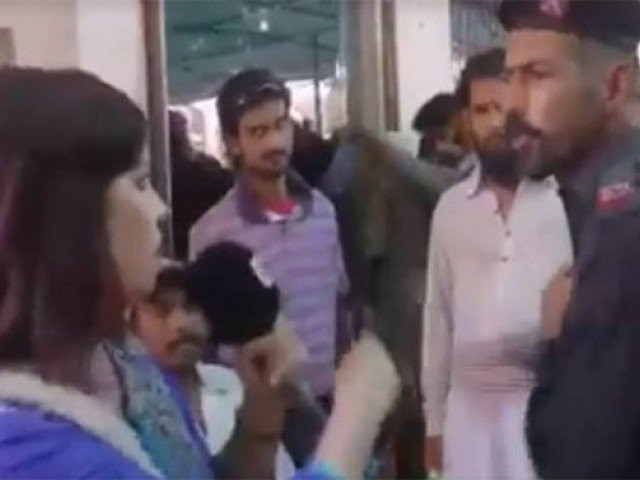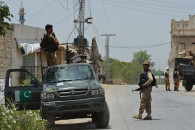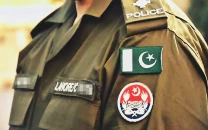Why the Saima Kanwal case has everything to do with sexism
All one seems to stumble upon are the she-asked-for-it and it-was-justified-what-with-her-behaviour comments

SCREENGRAB
The viral footage of Saima Kanwal, reporter of K21 News channel, getting slapped by a Frontier Constabulary guard, as she reported mismanagement of and from the NADRA office in Karachi, is one such instance. One which, though undoubtedly underscores several tiers of social problems including that of police brutality, abuse of gun rights, and media ethics, serves as an alarming eye-opener for how concerns that are to do with women, such as violence and workplace equality, are habitually pushed under the carpet, and offhandedly dismissed for ‘more pressing’ issues.
At this, one is unwittingly reminded of sociologist Gaye Tuchman’s book, The Symbolic Annihilation of Women by the Mass Media, in which she attributes the matter to the tools of “omission, trivialisation and condemnation”. Regretfully, her thesis stands just as correct today. If stark (mis)representation of females on-screen – when there is representation at all – in all kinds of fictionalised and entertainment segments is rife with stereotypes and caricatures are revolting, the state of women in newsrooms and behind the screens is hardly a matter of pride.
FC guard booked for slapping female reporter in Karachi
Scores of researches over the past decades have not only statistically validated this marginalisation, but proven gender balance of journalists on a given case affects the produced content. A study on HPV vaccine coverage, for example, showed how the involvement of female reporters resulted in more frequent, prominent and diverse reporting. And yet, female journalists are both, allotted, and seen as more befitting of soft news content with social, cultural and entertainment-based angles, rather than political or economic. This indeed remains of little surprise, when these content genres themselves are split into being of masculine and feminine readership-value, and their newsworthiness weighed as such.
Considering all this, the outcry on social media of those resistant towards the idea of interplay of gender in the K21 case has been loud, persistent and borderline ridiculous. This opposition could still have been said to be relatively excusable if the dominant or replacement stream of discourse had centered around media ethics or police brutality as a norm. But all one seems to stumble upon are the she-asked-for-it and it-was-justified-what-with-her-behaviour comments making their rounds as they do every time a story about rape is brought to light.
But the unfortunate truth of the matter is this: Female reporters get ‘it’ and have been getting it for decades without asking for it. In May this year, a video of Anna Baranova, a Russia Today correspondent went online as a protester snuck up from behind and punched her in the face as she was looking in the camera, peacefully reporting a demonstration against new labour laws in Paris. Ironically, Baranova was lauded for emitting no reaction and continuing to report as if nothing had happened. In another similar case, Lisa Evers continued reporting live, using her spare hand to brush off a bystander who continued to harass her by trying to put a dollar bill in her shirt.
Harassment incident: ‘PTI capable of protecting its women’
Closer to home are the cases of Abb Tak reporter manhandled by a mob as she reported on Eid in a Multan PTI jalsa, and Geo News reporter Sana Mirza being pelted with bottles and stones as she strove to report from atop a news van. If there were any doubts about the evidence and patternicity of female subjugation through violence and harassment in Kanwal’s case, there is little that can be said in argument for the above.
This stays not only an issue of rape culture – a system that strips the perpetrator of accountability and makes the victim answerable by stacking blame and burden of proof on him/her, resulting in terror and increased criminal activity – but also of cultural violence, aligned to silence women and helped on by social legitimisation and acceptance of brute force. Both of these phenomena are sustained and promoted by any combination of stigma, social tolerance, lack of bystander intervention, and law-regulation failure. Perhaps all of these ring true in the present case.
It boils down, then, to the pervasive play, be it unconscious or conscious, intentional or unintentional, of an undercutting of female agency and power. Hence, declarations upon women’s ‘liberty’ are easy to make and easier to accept merely by looking at the increasing number of women populating the outdoor workforce and occupying positions in mass media. But real and holistic progress requires closer, albeit shame-inducing, self-scrutiny.
Arfa Ezazi is an English Literature major and co-editor of the bilingual literary magazine, Zau.



















COMMENTS
Comments are moderated and generally will be posted if they are on-topic and not abusive.
For more information, please see our Comments FAQ